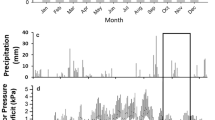Abstract
While photosynthetic responses of C3 plants to elevated CO2 are fairly well documented, whole-plant water use under such conditions has been less intensively studied. Woody species, in particular, have exhibited highly variable stomatal responses to high CO2 as determined by leaf-level measurements. In this study, sap flux of Pinus taeda L. saplings was periodically monitored during the 4th year of an open-top chamber CO2 fumigation experiment. Water use per unit sapwood area did not differ between treatments. Furthermore, the ratio of leaf area to sapwood area did not change under high CO2, so that average canopy stomatal conductance (on a unit leaf area basis) remained unaffected by the CO2 treatment. Thus, the only effect of high CO2 was to increase whole-plant water use by increasing sapling leaf area and associated conducting sapwood area. Such an effect may not directly translate to forest-level responses as the feedback effects of higher leaf area at the canopy scale cannot be incorporated in a chamber study. These feedbacks include the potential effect of higher leaf area index on rainfall and light interception, both of which may reduce average stomatal conductance in intact forest canopies.
Similar content being viewed by others
Author information
Authors and Affiliations
Additional information
Received: 13 March 1998 / Accepted: 8 July 1998
Rights and permissions
About this article
Cite this article
Pataki, D., Oren, R. & Tissue, D. Elevated carbon dioxide does not affect average canopy stomatal conductance of Pinus taeda L.. Oecologia 117, 47–52 (1998). https://doi.org/10.1007/s004420050630
Issue Date:
DOI: https://doi.org/10.1007/s004420050630




